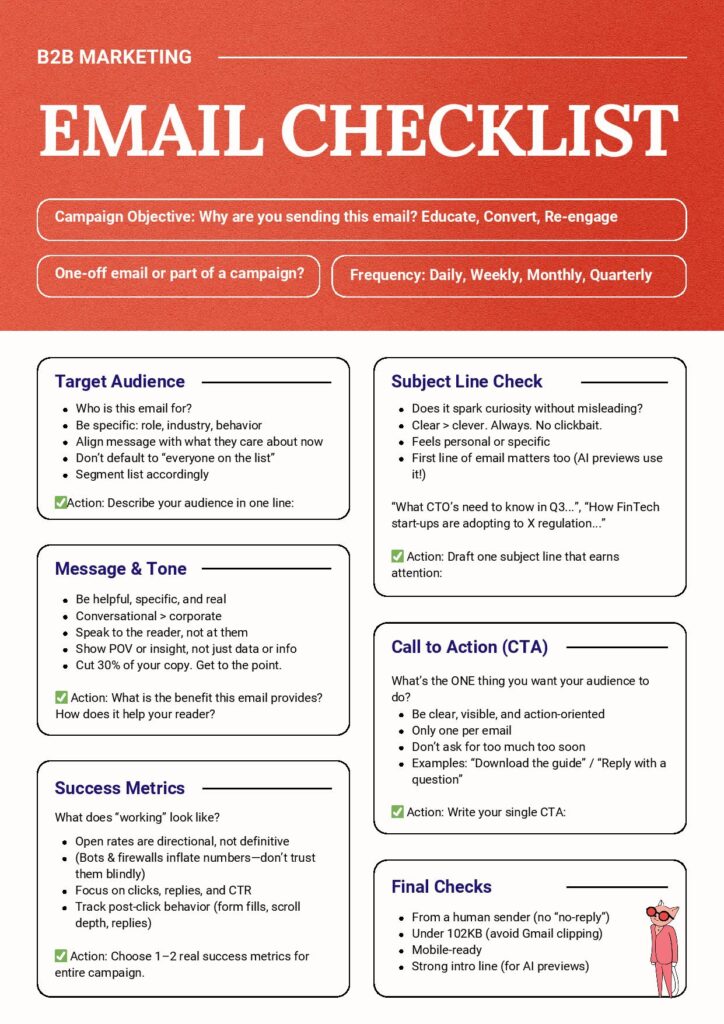Your B2B Email Playbook:
7 ways to build trust with your audience.
Email often gets overlooked. But in long B2B sales cycles, it’s still one of your most powerful tools. Most companies treat email like a megaphone—shouting announcements, offers, and newsletters. But email isn’t a broadcast channel.
It’s a relationship channel.
Used well, it builds trust, keeps you top-of-mind, and makes it easier for someone to say “yes” when the time is right.
💡 73% of B2B marketers say email is their most effective channel for reaching prospects.
1. Rethink the Role of Email in Your Marketing Strategy
Email doesn’t work on its own. It’s part of a bigger system. Smart B2B marketers don’t treat email like a campaign. They treat it like a conversation. Every send is a chance to build recognition, earn trust, or move someone one step closer to a decision. Even if they don’t click. Even if they’re not ready to buy.
2. Stop Sounding Like Everyone Else
Most B2B emails sound like they were written by legal, approved by procurement, and forgotten by the reader. If your email blends in, it gets ignored.
Here’s how to fix that:
- Drop the corporate tone. Write like a person.
- Share a clear point of view, not just an update.
- Ask yourself: Would I reply to this if it landed in my inbox?
3. The Metrics That Actually Matter
Open rate is a signal, not a success metric. Yes, it’s helpful. But on its own, it tells you very little.
Better metrics to track:
Click-to-open rate (CTOR): Did the content match the subject line?
Replies: Pure gold. Real engagement.
Conversion: Did people take action after they clicked?
Remember: Clicks aren’t the goal. They’re the starting line.
What matters is what happens next:
Did they scroll?
Did they read?
Did they take action?
Your email is just the beginning. Design it with the next step in mind.
🧠 Pro tip: Send an email at 2 a.m. (audience's time zone).
If it gets clicks right away, it’s likely a bot or firewall. Don’t trust the number without checking.
4. How to Use Personalization in Emails
Dropping a first name in the subject line doesn’t cut it anymore. Real personalization is about relevance.
Try these:
By role: “For heads of product…”
By industry: “If you’re in fintech, here’s what’s changing…”
By lifecycle stage: “You just downloaded X—here’s what to do next.”
Pro tip: And don’t forget to exclude people who shouldn’t get the email, for example:
- Active sales conversations
- Customers waiting on a fix
- Anyone for whom this email doesn’t apply
🎯 Emails with personalized content drive 6x higher transaction rates.
5. AI Summaries Are Changing the Game
- Start strong—your first line matters
- Don’t rely on images alone (AI can’t read them)
- Make your CTA obvious and early
🧠 AI-optimized emails see a 13% increase in CTR and 41% more revenue.
6. How to Structure Your Emails: Design for the Scroll
Most people don’t read. They scan. That means:
- Short paragraphs (1–3 lines)
- Clear section headers
- Bullet points > blobs of text
- Strategic bolding to guide the eye
And watch your file size. Keep emails under 102KB or Gmail will clip them—and you’ll lose visibility and tracking.
7. Re-Engagement Emails: Make It Easy to Say "Yes"
If someone stops opening, don’t panic and don’t pressure.
Don't Use Clickbait—You're Not BuzzFeed
Nothing erodes trust faster than a misleading subject line. If your subject says “Important update” and it’s just a blog post? That’s a bad experience—and it damages your brand. Curiosity is good. Clarity is better. Always deliver on what you promise.
TL;DR: Treat Email Like a Relationship, Not a Broadcast
- Write like a human
- Send something worth opening
- Segment like it matters (because it does)
- Follow the click. Track the actual impact
Bonus: Your B2B Email Checklist
Need a quick-hit guide to sharpen your next send?
Check out The Smarter B2B Email Checklist—a single-page cheat sheet with best practices, metrics to track, and instant improvements.


